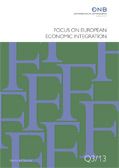Focus on European Economic Integration Q4/19
 OeNB
OeNB
- Erschienen:
- November 2019
 OeNB
OeNB
Call for applications: Klaus Liebscher Economic Research Scholarship (PDF, 55 kB) en 29.11.2019, 00:00:00
Developments in selected CESEE countries: International headwinds take a toll on economic activity (PDF, 1,3 MB) en 29.11.2019, 00:00:00
Outlook for selected CESEE countries: CESEE-6 show strong investment momentum in 2019 followed by softening growth dynamics – subdued growth continues in Russia (PDF, 257 kB) en 29.11.2019, 00:00:00
The impact of labor cost growth on inflation in selected CESEE countries (PDF, 1,8 MB) De Luigi, Huber, Schreiner. We analyze the relationship between labor cost and inflation in selected economies in Central, Eastern and Southeastern Europe (CESEE) by using a medium-scale time-varying parameter vector autoregressive model. The proposed framework makes it possible to control for potential movements in the underlying transmission mechanisms, stochastic volatility and flexible model selection. We use our model to simulate the effect of an unexpected labor cost shock and assess the dynamic reaction of inflation over the estimation period. Our findings indicate that a 1 percentage point increase in unit labor cost translates into higher inflation rates in most countries considered. However, the magnitude of the inflation reaction is very heterogeneous across countries and over time: the lowest response was observed for Bulgaria between 2008 and 2012 and the highest median response for Hungary between 2005 and 2007 (more than 0.4 percentage points). Moreover, we find that the wage-inflation pass-through weakened after the global financial crisis for most countries under consideration. en inflation, pass-through, labor cost, Bayesian methods, time-varying parameters C11, C15, C32, E24, E31 29.11.2019, 00:00:00
Homeownership and housing finance patterns one generation after the fall of communism
(PDF, 3,8 MB)
Beckmann, Hainz, Pyle, Reiter.
Drawing on a recent wave of the OeNB Euro Survey, we document current homeownership patterns across ten countries in Central, Eastern and Southeastern Europe (CESEE-10), the demographic characteristics of homeowners and the connections between their housing assets and the household credit market. Due to the experience of Central, Eastern and Southeastern Europe (CESEE) with both communism and postcommunist privatization reforms, homeownership rates in the CESEE countries are among the highest in Europe. However, the demographic
characteristics of homeowners we observe in the CESEE-10 now largely resemble those observed in more mature market settings. Despite high homeownership rates, the percentage of CESEE-10 households with housing loans is relatively small and homeowners infrequently use their dwellings to secure housing loans. However, we find that homeowners do use real estate as collateral for loans that are not used to finance house purchases.
en
housing, residential real estate, household assets, personal finance, CESEE
R31, D14, P30, G21
29.11.2019, 00:00:00
The OeNB’s 85th East Jour Fixe Ukraine: political, economic and migration challenges (In cooperation with the National Bank of Ukraine) (PDF, 92 kB) en 29.11.2019, 00:00:00
24th Global Economy Lecture Danny Quah on “Demand and supply in a new world order: the role of non-great powers” (PDF, 71 kB) en 29.11.2019, 00:00:00
Statistical annex (PDF, 118 kB) en 29.11.2019, 00:00:00